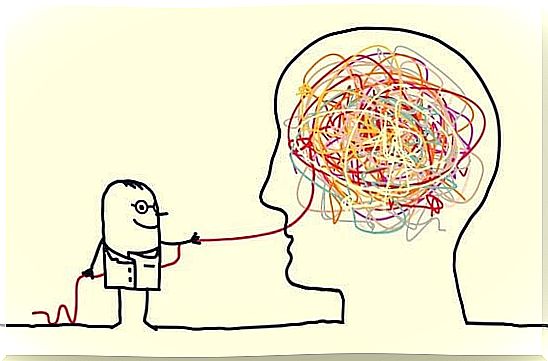Cognitive Defusion Helps Us Fight Unwanted Thoughts

Cognitive defusion is a technique that comes from cognitive therapy. Its duty is to reduce those unwanted thoughts that appear in our mind and that we have the impression that they are directing our life. We can call these thoughts obsessive or ruminant, among others.
The main characteristic of these thoughts, and the difficulty we encounter in eradicating them, lies in the fact that they revolve around our mind. In addition, we feed them ourselves. The ingredients that appeal to them the most are concerns and fears.
For all these reasons, running away from these kinds of thoughts is not the answer, and neither is ignoring them. What cognitive defusion offers is to teach us to relate to these types of intrusive thoughts. How do we get there? Through certain exercises that help us to distance ourselves from them and see them from another point of view, from another perspective.
Cognitive defusion tries to teach us to stop merging with those unwanted thoughts that limit us on a daily basis. We cannot concentrate, we sleep badly, and even while exercising, our mind is filled with intrusive thoughts … This reality, it is essential that we know how it is constructed. Therefore, before we deal with cognitive defusion in depth, let’s take a look at how thoughts of this type are created.

The way we merge with unwanted thoughts is that we believe in those thoughts. We are not able to see them in a contemplative way (from the outside), as mindfulness teaches us to do. That is why we consider these thoughts to be something very important that requires our full attention, so that no activity can make them haunt us over and over again.
It is also customary to regard these types of thoughts as absolute truths. Usually, these are not thoughts that we like, which is why indirectly they become a kind of threat. So we cling to it even more, using inappropriate strategies to free ourselves from it.
It all has an emotional impact as well. Every such thought that we focus on generates very strong emotions in us. It may be that we feel an intense fear, that the anxiety is on edge … It is natural, because there is a threat against which we try to defend ourselves.
To put an end to this unpleasant situation for those who live it and to know how to act in the event that it recurs, cognitive defusion offers certain exercises. Putting them into practice whenever we need to, it will help us “de-merge” with these thoughts. In time, this will become an automatic process for us, so that we will no longer cling to any thought of this type.
All cognitive defusion exercises have three goals : the first is to be able to identify and lay bare thought; the second is that we can feel it as strongly as possible; the third, finally, is that we manage to let go or free it. Let’s discover together in the rest of this article some exercises that help to achieve this:
This first exercise of cognitive defusion consists in taking this thought which disturbs us and to put it in the following sentence: “I am / I am not…”. The objective is that we can complete it in accordance with our own experience. For example, imagine the following sentence: “I am not valid”. We can write this sentence, or just say it out loud.
Now we are going to get into this sentence. We will feel invalid, and images of situations where we feel that way may even come to mind. Also, it is possible that sentences appear in our minds spoken by people that have made us feel this way.

Well. Once we get to this point, where we realize that we are not valid, we will take the following sample sentence and match that thought to it. It would give: “I think I am…”. Now we have to say it out loud. What do we think? “I think I am invalid.”
Perfect ! What happened ? Suddenly we let go of that thought completely. We see it from a certain perspective, albeit a small one; this is a big step forward. Repeating this last statement several times will help us to take some distance with our thoughts, but also to apply the second exercise.
We have called this exercise this way because we think the name sums up its purpose very well. To achieve it, we are going to take a word that we like. For example, “green”. Well. Next, we will repeat the word “green” several times. By repeating it over and over for a while, we will probably find that it has lost its meaning.
Suddenly, we forget the definition of the word, and we see it as a series of sounds coming out of our mouth. It may even be visualized with all its letters, but empty of any meaning. It is even possible that we have the impression of seeing a word in a language that we do not know.
Perfect. Then we will take the group of words “invalid”. We will repeat these two words until their meaning is diluted in the movements of our mouth and the vibrations of the sounds we speak. Thought, at any moment, will cease to make sense.

These two exercises are very interesting in order to take a little distance from intrusive thoughts. However, it is important to ask yourself a few questions after successfully completing these exercises.
Surely now, we see it much more clearly and that we want to give the answer to all these questions a big “no”. This will allow us to let go of that thought and let it go. The definitive passage to free us from ruminant ideas that previously we could not get rid of.
Cognitive defusion is a very effective technique for combating unwanted thoughts. Thoughts that can cause you to not enjoy life as much, to be subject to constant sadness and everything to be meaningless.
When we see thoughts as they are, that is, as mere ideas in our mind, and distance themselves from them, everything becomes clearer. Before, it seemed like we had a dense cloud above our heads. Now, thanks to cognitive defusion, that cloud is slowly dissipating.









